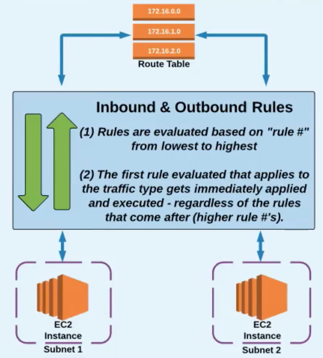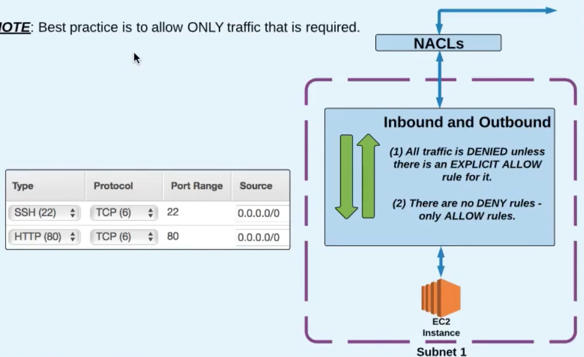Virtual Private Cloud (VPC) Essentials:
"Amazon VPC enables you to launch Amazon Web Services (AWS) resources into a virtual network that you've defined. This virtual network closely resembles a traditional network that you'd operate in your own datacenter, with the benefits of using the scalable infrastructure of AWS"
A VPC is designed to resemble:
- Private on-premise data centers.
- Private corporate networks.
Private network features available in AWS VPCs:
- Private and public subnets.
- Scalable architecture.
- Ability to extend corporate/on-premise network to the cloud as if it was part of your network (VPN).
Important VPC Facts:
- A VPC is housed within a chosen AWS region.
- A VPC spans multiple availability zones within a region.
- This allows you to provision redundant resource in separate availability zones while having them accessible on the same network (foundation of high availability and fault tolerant architecture).
- AWS provides a DNS server for your VPC so each instance has a hostname. However, you can run your own DNS servers by changing the DHCP option set configuration within the VPC.
Benefits of VPC:
- Ability to launch instance into a subnet.
- Ability to define custom CIDR (IP address range) inside each subnet.
- Ability to configure routes between subnets via route tables.
- Ability to configure an internet gateway to provide a route to the internet for the resources launched inside the VPC.
- Ability to create a layered network of resources.
- Ability to extend your on-premise network into the cloud with VPN/VPG and an IPsec VPN tunnel.
- Layered Security:
- Instance level Security Group (firewall on the instance level).
- Subnet level network ACLs (firewall on the subnet level).
The Default VPC:
- The default VPC is the VPC that comes preconfigured in your AWS account when it is first created.
- The default VPC has a different setup than a non-default VPC.
- The default VPC is meant to allow the user easy access to a VPC without having to configure it from scratch.
- In the default VPC, all subnets have a route to the internet via route table and an attached IGW.
- Each instance launched in the default VPC (by default) has a private and public IP address (defined on the subnet settings).
VPC Limits:
- 5 VPCs per region (more reliable upon request).
- 5 internet gateways per region (this is equal to your VPC limit because you can have one internet gateway attached to a VPC at a time).
- 50 customer gateways per region.
- 50 VPN connections per region.
- 200 route tables per region / 50 entries per route table.
- 5 elastic IP addresses.
- 500 security groups per VPC.
- 50 rules per security group.
- 5 security groups per network interface (security groups although generally referred to as being on the instance level are technically on the VPC level).
Internet Gateway:
- Is a VPC component that allows communication between instances in your VPC and the internet.
- Is a horizontally scaled, redundant and highly available.
- It imposes no availability risks or bandwidth constraints on your network traffic.
- Provides NAT translation for instances that have a public IP address assigned (public IP to private IP).
NOTE: Your "default" VPC already has a IGW attached.
Internet Gateway rules and details you need to know:
- Only 1 IGW can be attached to a VPC at a time.
- An IGW CANNOT be detached from a VPC while there are active AWS resources in the VPC (such as an EC2 instance or RDS database).
- An IGW must be attached to a VPC if the resources inside the VPC need to connect to resources via the open internet.
"To enable access to or from the internet for instances in a VPC subnet, you must attach an Internet Gateway to your VPC, ensure that your subnet's route table points to the Internet Gateway, ensure that instances in your subnet have a public IP address or Elastic IP address, and ensure that your network access control and security group rules allow the relevant traffic to and from your instance." - AWS
Route Tables:
"A route table contains a set of rules, called routes, that are used to determine where network traffic is directed." - AWS
- A route table's rules are comprise of two main components:
- Destination: The CIDR block range of the target (where the data is routed to).
- Target: A name identifier of where the data is being routed to.
- By default, all subnets traffic is allowed to each other available subnet within your VPC which is called the local route.
- You cannot modify the local route.
- Unlike an IGW, you can have multiple "active" route tables in a VPC.
- You CANNOT delete a route table if it has "dependencies" (associated subnets).
Best practice is to leave the default route table and create a new route table when new routes are needed for specific subnets.
NOTE: The "default" VPC already has a "main" route table.

Subnets:
"When you create a VPC, it spans all of the Availability Zones in the region. After creating a VPC, you can add one or more subnets in each Availability Zone. Each subnet must reside entirely within one Availability Zone and can NOT span zones." - AWS
- Subnets MUST be associated with a route table.
- A PUBLIC subnet HAS a route to the internet.
- It is associated with a route table that has an IGW attached.
- A PRIVATE subnet does NOT have a route to the internet.
- It is associated with a route table that does NOT have a IGW attached.
- Instances launched into a private subnet can NOT communicate with the internet.
- This creates a higher level of security, but it creates a limitation of an instance not being able to download software and/or updates.
- This issue is solved by routing traffic through a NAT instance.
- By default all subnets traffic is allowed to each other available subnet within via the local target in the route table.
- A subnet is located in one specific Availability Zone, and does not span AZs.
NOTE: The "default" VPC already has subnets created and associated with a route table.
Network Access Control List (ACLs) Essentials:
- ACLs operate at the network/subset level.
- They support allow AND deny rules for traffic traveling into or out of a subnet.
- They are stateless: so return traffic must be allowed through an outbound rule.
- They process rules in number order when deciding whether to allow traffic.
- Rules are evaluated in order, starting with the lowest rule number - for example:
- If traffic is denied at a lower rule number and allowed at a higher rule number, the allow rule will be ignored and the traffic will be denied.
- The last rule in every ACL is a "catch all" deny rule:
- This means that unless a protocol/port is explicitly allowed, it will be denied.
- A network access control list (NACL) is an optional layer of security for your VPC that acts as a firewall for controlling traffic in and out of one or more subnets.
- Best practice to increment numbers by 10 so if you have to place in a rule in a certain order it does not create an issue.
NOTE: Your "default" VPC already has a NACL and it is associated with the default subnets.

ACL Rules:
- Rules are evaluated from lowest to highest based on "Rule #".
- The first rule found that applies to the traffic type is immediately applied, regardless of any rules that come after it (have a higher "Rule #").
A subnet can only be associated with ONE NACL at a time.
An NACL allows or denies traffic from entering a subnet. Once inside the subnet, other AWS resources (i.e. EC2 instance) may have an additional layer of security (security groups).

Security Groups:
- Security groups are very similar to NACLs in that they allow/deny traffic.
However, security groups are security for the instance level (as opposed to the subnet level with ACLs).
In addition, the way allow/deny "rules" work are different from ACLs:
Security groups support only allow rules.
They are stateful: so return traffic requests are allowed regardless of rules.
All rules are evaluated before deciding to allow traffic.
NOTE: Best practice is to allow ONLY traffic that is required.

 su
su